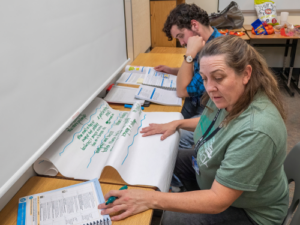School districts often have good reason to modify instructional materials for their local context, even high-quality instructional materials. BSCS Science Learning provides assistance with customizing instructional materials to schools and districts as a professional service.
Why Districts Seek Curriculum Customization
Sometimes districts determine that a particular instructional program is the best available fit for their needs but decide that it is necessary or desirable to modify it to improve its fit. One common reason is that the state or district objectives for the course differ from those used by the program developers. Another is that the district sees opportunities to use locally-meaningful phenomena to enhance students’ engagement.

Customizing instructional materials can be a challenging task, particularly high-quality science materials that have been carefully designed for coherence and sequenced to develop concepts and practices over time. Often a change in part of an instructional sequence can have unintended consequences in other places. Without a full understanding of the instructional model used by the designers and the blueprint behind the program being customized, it is easy to “break” important aspects of the program. In addition, making substantial changes to an instructional program can pose planning and coordination challenges that some districts are not prepared to take on by themselves.
How BSCS Supports Districts
Recognizing both the compelling reasons why districts want to customize instructional materials, BSCS has developed strategies, tools, and processes for adapting high quality science materials for local contexts. Understanding the challenging nature of actually doing the customization, we have decided to offer a variety of curriculum customization services to districts.
- BSCS can customize materials for districts.
- BSCS can provide professional learning experiences for district personnel to build the capacity to customize materials themselves.
- Or, we can do a combination of both.
At this time, BSCS is offering curriculum customization services for OpenSciEd programs at all levels and for BSCS Biology: Understanding for Life.